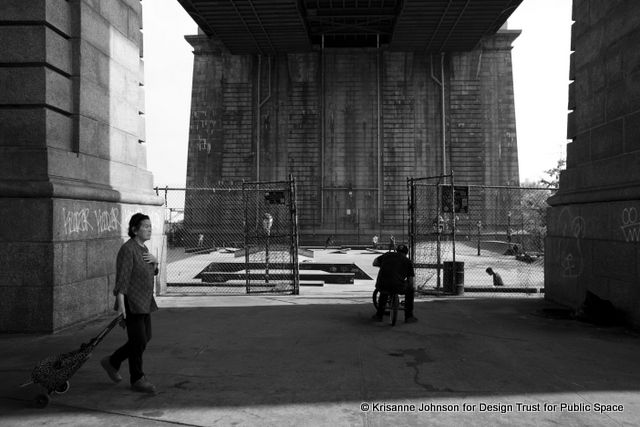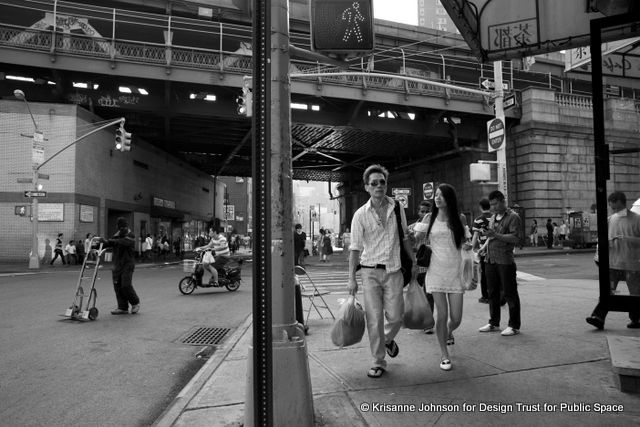The Berkshires Bowling Alley that Inspired "The Big Lebowski"
It’s been 36 years since the release of The Big Lebowski, the irreverent cult comedy by Joel and Ethan



Scandinavian folklore holds that trolls once lurked under bridges, demanding payment from all who crossed and attacking those who refused. In New York, we have the Port Authority to collect our tolls, and New Yorkers stay away from bridge underpasses for altogether different reasons. There are almost 700 miles of elevated road and rail lines snaking through the city, and in many cases the space underneath them is dark, litter-strewn, or just plain scary.
So in the last few months, the nonprofit Design Trust for Public Space has been soliciting ideas from residents across the city for ways to reprogram the forgotten space. The project, called Under the Elevated, will culminate in a publication outlining design and policy recommendations for enlivening some of the city’s trickiest real estate.
The Design Trust identified seven sites to investigate up close – sites that are characteristic of many of the conditions seen under New York’s overpasses. But each poses unique problems and opportunities. The space under the elevated Freeman Street subway station in the Bronx is noisy and crowded with vendors and commuters, while the Washington Bridge in upper Manhattan is nestled in the lush and secluded Highbridge Park. What each site has in common, they found, is that locals avoid them. In the Bronx, storeowners under the tracks reported that they close as early as 4 p.m. in the winter because shoppers are too nervous to trek those sidewalks in the dark.
Chinatown” src=”https://untappedcities.com/wp-content/uploads/2013/11/under_the_elevated-chinatown-manhattan_bridge-skate_park-design_trust-untapped_new_york.jpg” width=”640″ height=”426″ /> A skate park under the Manhattan Bridge in Chinatown
At community workshops organized at three of the sites, participants pitched ideas ranging from the practical (elevators to improve transit access for pedestrians) to the fantastical (waterfalls cascading from above). Design Trust fellow Chat Travieso said the best suggestions came from kids, often uncannily attuned to their environments. Rock climbing walls, bike parking, and skate parks were suggested as well.
Of course some underpasses aren’t underutilized at all. Farmers markets and dance festivals regularly huddle under the Metro North viaduct in Harlem. In Chinatown, seafood and produce vendors rub shoulders with hooded skateboarders. The Design Trust aims to not only continue to accommodate these uses, but also to encourage and expand them.

Some underpasses are already crowded with vendors and pedestrians
One of the most astounding underpass success stories was the transition of a dank industrial district in Brooklyn to one of the most exclusive neighborhoods in the city. Dumbo, or Down Under the Manhattan Bridge Overpass, was named by artists in the 1970s who hoped a silly label would repel gentrification. For years, art galleries and wine bars sprouted up in the shadow of the bridge while the underpass itself was walled off, ostensibly for safety reasons. Today, the Dumbo archway plays host to arts festivals and Christmas tree lightings. Caroline Bauer of the Design Trust points to the walkway as a truly inviting piece of down-under infrastructure.
The Design Trust has looked at examples of successful underpass revitalization outside of New York City as well. Underpass Park in Toronto features a playground, skate park and basketball courts under a tangle of elevated roadways near the lakefront. Tokyo’s 2k540 Aki-Oka Artisan is a cluster of artist studios, galleries and cafes wedged under an elevated rail station. In the 1980s, the City of Seattle commissioned a group of sculptors to carve a giant troll statue under a bridge in the city’s Fremont neighborhood to help turn around a nook that had succumbed to dumping and drug dealing.
Harlem” src=”https://untappedcities.com/wp-content/uploads/2013/11/under_the_elevated-harlem-metro_north-la_marqueta-east_harlem-dancing-design_trust-untapped_new_york.jpg” width=”640″ height=”427″ /> A dance festival takes place under the Metro North viaduct in Harlem
But for one piece of inspiration, the Design Trust looked no further than its own playbook. In 2002, the organization coauthored Reclaiming the High Line to highlight the potential benefits of converting a crumbling elevated railway into a park. Since the first leg opened in 2009, the High Line has immeasurably transformed Manhattan’s West Side. And the High Line is just 30 feet wide and a mile long. Just imagine the impact of unlocking millions of square feet of concrete and chain link across the city for art, leisure, commerce or recreation.
In the High Line’s early days, critics laughed at the prospect of New Yorkers climbing a couple flights of stairs to access open space. The Design Trust is now hoping to smash the timeworn assumption that New Yorkers won’t venture beneath highways and train tracks for open space. Trolls, be warned.

Noise, darkness and trash are the complaints often aired about underpass spaces
All images created by Krisanne Johnson for her 2013 Photo Urbanism fellowship at the Design Trust for Public Space. To learn more, click here.
Subscribe to our newsletter